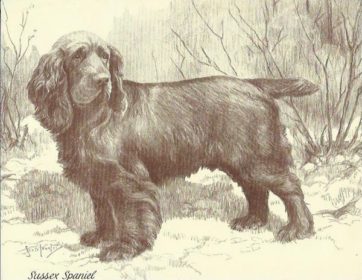
In the dog world, “giving tongue” doesn’t mean what non-dog owners might think it means. Hound owners in particular know all too vividly that the term refers to the excited crying-out of dogs in pursuit or who are just fired up. The video below gives you a good idea:
As hunting dogs, go, spaniels do not typically “give tongue,” but there is one spaniel breed that does, the Sussex Spaniel. Originally developed by Augustus Elliot Fuller of Rosehill Park Estate in Sussex County, England, Fuller created a sturdy field dog that could insinuate itself into dense brush to flush game for its hunting owner. The Sussex Spaniels were kept as working dogs on his large estate for some 50 years until the 1850’s.
Fuller had recruited other breeds to fine tune his spaniel, among them, it’s thought, the now extinct Norfolk Spaniel, early variations of the Springer Spaniel, the Field Spaniel, and, as is suggested by the Sussex Spaniel’s long ears, loose skin, and heavy build, a few hound breeds. There is one other thing the Sussex may have inherited from those hounds, and that is the tendency to give tongue when tracking, not common in most spaniel breeds; it’s a trait that allows a hunter to keep track of the dog when he or she isn’t visible.
Typical of the breed is a natural quartering close to the gun at a slower and more deliberate speeds than some other spaniels. A dog that gives voice is, as writer, 016, like “having a natural built-in beeper locator…for keeping track” of the dog.
Image: Sussex Spaniel by Scott Langley, a vintage print from 1935 is available from here

The Sussex spaniel existed before A E Fuller, he did not developed them. He was rarely at his estate in Sussex. His Sussex Spaniels came from another breeder in E Sussex, called Monypenny. He need only to have sufficient dogs to satisfy his pastime of shooting on his estate and his son’s estate on Angelesy in Wales. A new book on the history of the breed is due out this year, based on extensive research, that will give more and accurate details on this.
Thanks for the heads up, Ki, we’ll look for the book and additional information, and update accordingly!